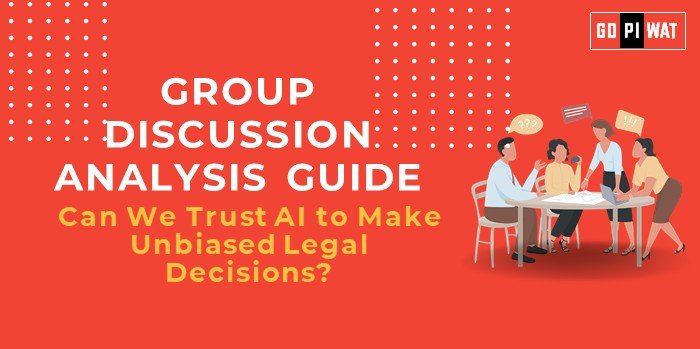📋 Group Discussion (GD) Analysis Guide: Can We Trust AI to Make Unbiased Legal Decisions?
🌐 Introduction to the Topic
Opening Context: Artificial Intelligence (AI) is reshaping industries globally, including law and judiciary. Its potential to deliver impartial and efficient legal decisions is a hot topic of debate, especially in light of ethical concerns about biases in algorithms.
Background: The idea of AI in legal decision-making stems from its use in predictive justice, legal research, and case management. Countries like the US and China are experimenting with AI judges for small claims courts, but controversies, including data bias and lack of transparency, persist.
📊 Quick Facts and Key Statistics
- Adoption of AI in Law: Over 50% of law firms in the US have implemented AI tools (2023) – showcasing the industry’s digitization.
- Bias in AI: Studies indicate AI sentencing algorithms can be up to 34% more punitive towards minority groups – highlighting systemic bias risks.
- Global AI Investment: $125 billion invested in AI technologies in 2023 (Gartner) – underlining AI’s rapid integration into various sectors.
- AI Judges: China deployed AI in over 3.1 million court cases (2023) – demonstrating the scale of automation.
👥 Stakeholders and Their Roles
- Governments: Develop AI regulations to ensure fairness and accountability.
- Judiciary: Experiment with AI for efficiency but ensure ethical oversight.
- Tech Companies: Build transparent, unbiased algorithms and datasets.
- Citizens: Demand fairness and participate in ethical AI discourse.
- Academia: Provide research on AI ethics and practical frameworks.
📈 Achievements and Challenges
Achievements:
- Efficiency: AI systems review legal documents 10x faster than humans.
- Cost Reduction: Automated systems reduce legal costs by up to 60%.
- Consistency: AI offers standardized rulings, reducing human error.
Challenges:
- Bias in Data: AI inherits biases from historical case data.
- Accountability: Lack of clear frameworks for AI’s legal errors.
- Transparency: AI decision-making often lacks explainability.
🌍 Global Comparisons
- Success: Estonia uses AI for pre-trial dispute resolutions with 80% satisfaction rates.
- Challenges: US sentencing tools like COMPAS faced backlash for racial bias.
📚 Case Study
China’s AI-assisted judiciary: Hangzhou courts reduced case backlog by 50% but raised fairness concerns.
🛠️ Structured Arguments for Discussion
- Supporting Stance: “AI’s consistency and speed make it a reliable tool for unbiased legal decisions.”
- Opposing Stance: “AI’s reliance on biased data risks perpetuating systemic inequalities.”
- Balanced Perspective: “While AI enhances efficiency, ethical safeguards are essential to ensure fairness.”
💡 Effective Discussion Approaches
Opening Approaches:
- “AI has resolved over 3 million cases in China—should other countries follow suit?”
- “AI offers speed but risks bias; is it the right solution for judicial impartiality?”
Counter-Argument Handling:
- “While AI reduces costs, concerns about bias remain valid. Solutions like diverse datasets and AI auditing could address this.”
🔍 Strategic Analysis of Strengths and Weaknesses
- Strengths: Speed, cost-efficiency, and consistency.
- Weaknesses: Bias, transparency issues, ethical dilemmas.
- Opportunities: Integration with human oversight, ethical AI development.
- Threats: Public distrust, legal errors, misuse.
🎓 Connecting with B-School Applications
Real-World Applications:
- AI in governance and ethics courses.
- Research projects on algorithmic fairness.
Sample Interview Questions:
- “How can AI overcome inherent biases in legal decisions?”
- “What regulatory measures are needed for AI in judiciary systems?”
Insights for Students:
- Explore AI’s role in shaping future governance and ethical frameworks.
- Analyze real-world impacts of technology on law and ethics.


